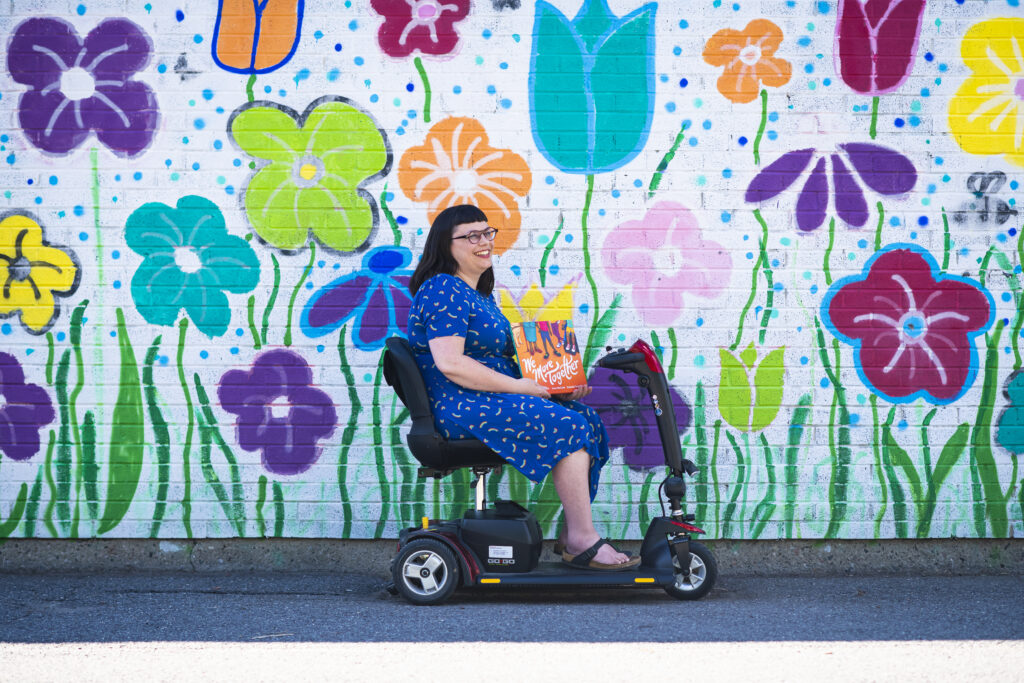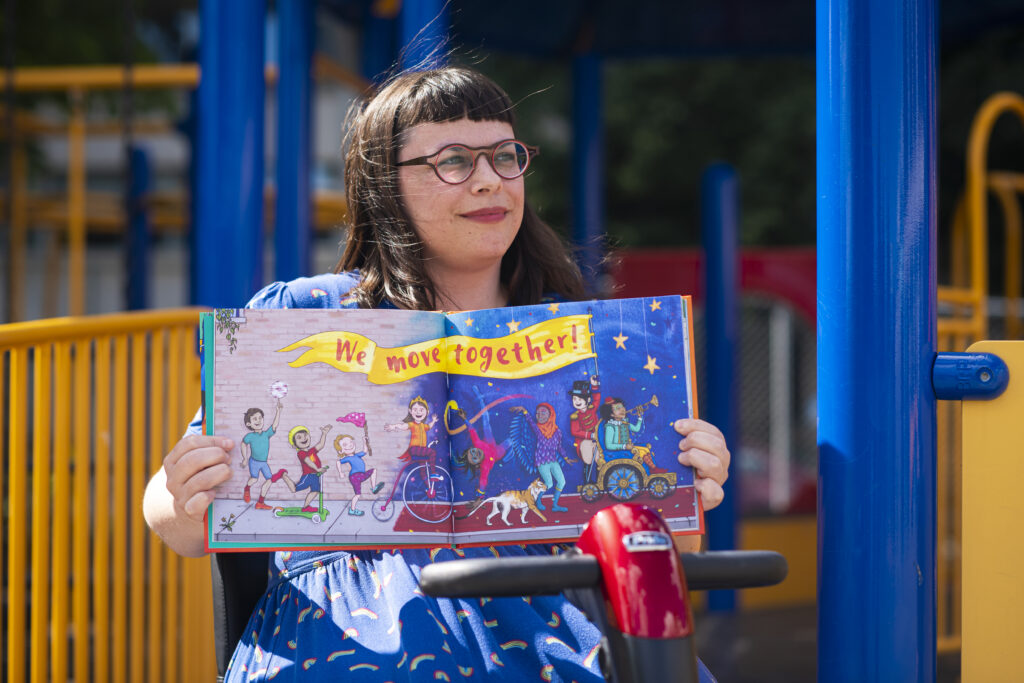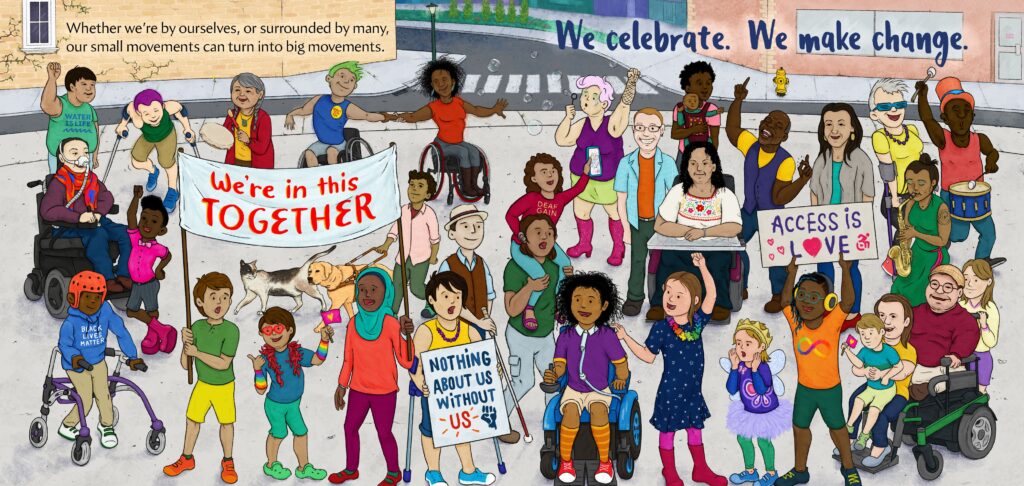The Transformative Power of Moving Together
Professor Kelly Fritsch co-authors a groundbreaking disability justice book for children.
By Nick Ward
Photos by Ainslie Coghill
We Move Together is a luminous and empowering exploration of our individual distinctions and the boundless potential of collective care.
Collaboratively written and illustrated by Sociology Professor Dr. Kelly Fritsch, Dr. Anne McGuire, Professor of Disability Studies at the University of Toronto, and graphic designer Eduardo Trejos, We Move Together chronicles the experiences of a diverse group of characters as they cleverly negotiate barriers and conflicts that impede their ability to move together. But more than that, We Move Together is a celebration of disability culture, community, and friendship, showing disability as a desirable part of our communities and world.
Aimed at children ages four to ten, the colourfully illustrated book is a captivating resource for any family, school, library, or community group endeavouring to promote discussion on accessibility, disability, and social justice.
“Our overarching goal was to share some of the transformative joy we’ve experienced in disability community as disabled people, disability studies scholars, and disability activists. We wanted to create a book that is anti-oppressive in its depictions of disability, showcasing positive representations of disabled communities. We also wanted to demonstrate that disability is a political identity, to show readers how our positive experiences of disability can be curtailed by social injustices like inaccessibility and ableism. And that these injustices are wrapped up with the concerns of other social movements,” explains Fritsch.
“To truly fight back against oppression in any form, we need to be taking up disability justice,” she says. “We Move Together invites readers to think about what disability justice might look like at the park, on public transit, or even when going out for ice cream.”
Through their four-year creative process, Fritsch, McGuire, and Trejos consulted with several groups and individuals, including academics, international disability communities, parents of disabled kids, and of course, children themselves.
“We wanted the book to feel as true to experience as possible and represent a wide range of visible and invisible disabilities, so we conducted extensive reviews with diverse disability community members and compiled an abundance of feedback on the story and images,” says Fritsch.
The generous feedback the authors received from these individuals and communities significantly influenced the final version of the book.
With their help, the project developed into a story that reflects the power of moving together – sometimes slow, sometimes fast, sometimes in conflict, and sometimes in celebration.
Dr. Fritsch
The trio also created a website for the book which features an open-access learning guide geared to grades 1-5. The guide includes lesson plans, discussion prompts, printable templates, and activities for use by primary school educators and community groups. The authors have also developed a variety of accessible tools to support book readers, including image and audio descriptions, ASL interpretation, and a text-to-speech enabled ebook.
“This is a book about disability community that was collaboratively created and grew out of disability community,” says Fritsch. “It is important to us that the book is accessible to diverse readers.”

Accessible Futures
Fritsch’s academic work is primarily situated in critical disability studies but also expansively draws on feminist science and technology studies, political economy, and critical criminology. From taking up the ways disabled people have designed their own accessibility tools, to the effects of neoliberalism on disability communities, to research looking at how disabled people are caught up in carceral systems of institutionalization and criminalization, an underpinning of all of Fritsch’s research is an ardent effort to advocate for different futures for disabled people.
“I strive to mobilize futures that are more accessible; futures that allow disabled people to thrive,” she explains. “Part of my work is imparting the joy and ingenuity of disabled life. This goes deeply against normative understandings of disability.”
Before joining the Department of Sociology and Anthropology in 2018, Fritsch, who is cross-appointed to the Pauline Jewett Institute of Women’s and Gender Studies and the Institute of Political Economy, completed her Ph.D. in Social and Political Thought at York University and was a Banting Postdoctoral Fellow at the Women and Gender Studies Institute at the University of Toronto.
Although she is still early in her career at Carleton, Fritsch is a prolific and sought-after scholar. Currently, she is working on three unique projects.
“I’m interested in how disability culture and politics shape our shared social world, how disabled people’s ways of resisting ableism or fighting for accessibility can transform social relations,” says Fritsch. “I’m also interested in what can be gained from failure, like when our struggles don’t succeed, or when our communities don’t agree, or when there are not obvious ways to resolve problems.”
A Broken Politics for a Disabled World is the working title of Fritsch’s current book project, also co-authored with McGuire. The book examines the failure of inoperative social infrastructures through a disability lens. “In the book, we consider how crip knowledge practices of repair and maintenance can reconfigure our collective understanding of what broken means in the context of mutual aid and community care,” Fritsch explains.
Fritsch is also co-Principal Investigator on the New Frontiers in Research Fund project Frictions of Futurity and Cure in Transplant Medicine: Re-Thinking Central Challenges Through Feminist/Crip Science and Technology Studies. As part of this mixed methods project, Fritsch collaborates with heart, liver, and kidney transplant patients and surgeons, artists, as well as project partners Tangled Art + Disability, a non profit arts organization, and the University Health Network in Toronto.

“Frictions engages ethnographic, narrative, and artistic research-creation practices to recast the standard practices and foundational principles of solid organ transplant,” Fritsch explains. “The project uses creative methods to probe the ways medical utility and technoscientific possibility can be at odds with the lived experiences of heart, liver, and kidney transplant recipients.”
Fritsch is also Director of the Disability Justice and Crip Culture Collaboratory, a recently formed research lab at Carleton that brings together disabled scholars, activists, artists, and designers working at the convergence of crip and disability arts, technoscience, and justice.
“It’s been exciting to launch the lab not only because of our shared research interests but also because we are building a community of disabled people at Carleton who are committed to enacting social change.”
Disability Injustice: Confronting Criminalization in Canada is the title of her forthcoming book, an edited collection that explores how disability is central to forms of criminalization and crime control in the Canadian context.
“Across 13 chapters, this book examines how ableism and disability oppression is embedded in Canadian criminological institutions, policies, and practices, showing how incarceration and institutionalization is dangerous and deadly for disabled people,” Fritsch explains. “It links eugenics and white supremacy to the ways the criminal justice system pathologizes disabled people as deviants, and how processes of criminalization depend upon discriminatory approaches to physical and mental health. The book highlights the significance of disability justice for fostering different futures for disabled people and contributes to contemporary abolitionist movements that seek to abolish not just criminal justice systems but also other forms of disabled incarceration like congregate care.”
With all these projects on the go, there are no immediate plans for a second children’s book. “But” says Fritsch, “it’s something we’re considering.”
“Long before I ever conceived of becoming an academic, I wanted to write kids’ books. It’s been deeply gratifying to creatively work in this medium and for the book to reach so many people. The three of us as an author-illustrator team work so well together that I can imagine us doing it again.”
Beginnings of We Move Together
The idea for We Move Together came to Fritsch and McGuire in 2017 when the pair were discussing books they were reading to their young children. Both Fritsch and McGuire lamented the difficulty they were having finding books taking up disability in ways relatable to children and, more generally, to the broader communities to which they belong.
“At the time, most books we encountered did not include diverse disabled characters or engage with disability as a social justice issue. The books we found were more about how sad or tragic disability is, depicting disability solely as a medical issue, or as a problem experienced by one individual,” says Fritsch. “Our frustration fueled our desire to create something better.”
Fritsch and McGuire had an abstract sense of what the book might look like and invited Trejos to collaborate.
“We didn’t want a book that told the reader what to think or that didactically presented a lexicon. We wanted to create a book that provoked the reader to look at the world differently and that would generate conversation and questions,” Fritsch says.
As Trejos began mocking up image ideas for the first draft, the group realized that much of the nuance of the story could be told through the illustrations rather than within the text, leading to simpler sentences. And by including a kid-friendly glossary at the back, the trio could further unpack some of the complexity contained in the illustrations.
“The glossary gives readers some vocabulary and background information related to the themes of the book, like interdependence, community, conflict, and accessibility. It also introduces the reader to real-life disabled activists and artists who are challenging inaccessibility and ableism,” Fritsch explains.

Their formula is paying dividends, as they have already received a very enthusiastic response to We Move Together.
“Overall, it’s been phenomenal,” says Fritsch. “People really identify with the book, its message, and illustrations. Everyone we have spoken with has been overjoyed – in person and on social media. For example, Sarah Jama, co-founder of the Disability Justice Network of Ontario has said that she wishes she could have had this book when she was a kid. Syrus Marcus Ware, co-founder of Black Lives Matter Canada has called it ‘essential reading for all bookshelves.’ Lydia Brown, an autistic disability justice advocate, said the book serves as ‘a love letter to the next generation of disabled kids.’”
“And in many ways it really is a love letter,” Fritsch says. “This book has been made possible through our connection to disability communities that have given us care, love, and support. The book is one way for us to give back.”